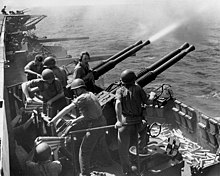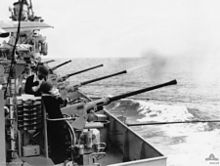Bofors 40 mm L/60 gun
For its time, the Bofors 40 mm L/60 was perfectly suited for this role and outperformed competing designs in the years leading up to World War II in both effectiveness and reliability.
A mechanism that was strong enough to handle the stresses of moving the large round was too heavy to operate quickly enough to fire rapidly.
Krupp engineers began the process of updating the Bofors factories with modern equipment and metallurgy, but the 40 mm project was kept secret.
The trainer and layer were both provided with reflector sights for aiming, while a third crew-member, standing behind them, "adjusted" for lead using a simple mechanical computer.
In spite of the successful development, the Swedish Navy changed its mind and decided it needed a smaller hand-traversed weapon of 13 mm-25 mm size, and tested various designs from foreign suppliers.
If time was available for set-up, the gunners used the tow-bar and muzzle lock as levers, raising the wheels off the ground and so lowering the gun onto supporting pads.
In order to deal with that, the British introduced a complex mechanical analogue computer, the Kerrison Director, which drove the laying electrically.
A three-man team operated the director by pointing it at the target whilst dialing in estimates for speed, range, and various atmospheric conditions.
[24] In combat, it was found that the Kerrison was difficult to set up in many situations, as well as making logistics more complex, due to the need to keep its electrical generator supplied with fuel.
Eventually, an anti-aircraft gunnery school on the range at Stiffkey on the Norfolk coast, delivered a workable solution, a trapeze-like arrangement that moved the pancake sights to offer lead correction, operated by a new crew-member standing behind the left-hand layer.
In British Army service, the Bofors found a highly specialised role: during the North Africa campaign, at the Second Battle of El Alamein, they were used to fire tracer horizontally to mark safe paths for units through the German minefields.
That practice was further developed during operations in north-west Europe, where bursts of colour-coded tracer were used to define the axis of advance of different formations in large-scale night attacks.
No 2875 Squadron RAF Regiment, employing the L60, became the first unit to shoot down a jet aircraft, a Messerschmitt Me 262, with ground-based anti-aircraft fire, at Helmond in the Netherlands on 28 November 1944.
[25] After World War II, the RAF Regiment continued to employ the L60 as its principal anti-aircraft weapon until it was replaced by the L70 gun in 1957.
After the German invasion of the Netherlands in May 1940, the Dutch minelayer, HNLMS Willem van der Zaan, gave the navy its first example of a water-cooled gun on its Hazemeyer tri-axially stabilized mounting.
The escaped Dutch Navy completed its HNLMS Isaac Sweers in England and fitted it with two twin-mounted Hazemeyer stabilized "QF 40 mm Mark IV" each connected to a RDF 289 (radar) range finder.
Most of the changes were in production methods rather than the design of the gun itself: for example, milling from steel block was replaced by stampings and castings whenever possible, and Amplex division of Chrysler (which normally manufactured oilite) produced nine parts by sintering.
[27][28] York Safe & Lock also produced the weapons, though its attempts to coordinate drawings across the program were unsuccessful, and this responsibility was transferred to the Naval Gun Factory in July 1943.
[29] There were many difficulties in producing the guns within the United States, beyond their complexity (2,000 subcontractors in 330 cities and 12 Chrysler factories were used to make and assemble the parts).
Chrysler had to translate to imperial measures and English language, fix absolute dimensions, and mirror/reorder the drawings to the third angle of projection.
Fourthly, the Swedish guns were air-cooled, limiting their ability to fire long bursts, a necessity for most naval AA engagements.
[4][29]The United States Navy's Bureau of Ordnance purchased a twin-mount air-cooled example, spare parts and 3,000 rounds of ammunition directly from Bofors, which arrived in New York on 28 August 1940 aboard the Army transport USAT American Legion, which had evacuated 897 people, including members of the Norwegian royal family, through the Finnish port of Petsamo.
40 mm weapons were eventually mounted on virtually every naval and armed auxiliary vessel larger than a small landing craft.
[29] After the war, the 3"/50 caliber gun Mark 27 twin mount began to replace the Bofors, because the "VT" proximity fuse would not fit a 40mm projectile, and the 40 mm weapon was considered inadequate against the emerging anti-ship missile threat.
[31] The Navy's satisfaction with the weapons was demonstrated by their practice of telegraphing Chrysler Corporation with the serial numbers of guns when they shot down an aircraft.
In early World War II, six British Bofors were imported for testing, along with Kerrison Predictor directors, and they proved to be superior in all areas.
II high-explosive shell as well as the M81A1 armor-piercing round, which was capable of penetrating some 50 mm of homogeneous armor plate at a range of 500 yards.
In the Army, each Anti-Aircraft Artillery (AAA) auto-weapons battalion was authorized a total of thirty-two 40 mm guns in its four firing batteries.
In German naval use, the gun was designated the "4 cm Flak 28", and was variously used aboard individual examples of many different classes of warship, including but not limited to; the cruisers Admiral Hipper and Prinz Eugen toward the end of the war; M1940-class minesweeper; vorpostenboot.
[citation needed] In United States Army service, the M19 Gun Motor Carriage was replaced by the M42 Duster, using the same turret but based on the chassis of the M41 Walker Bulldog tank.














